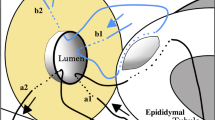Abstract
Background
Although the number of patients receiving vasoepididymostomies is gradually increasing, these individuals are limited in the recent advanced assisted reproductive technology (ART) era. A novel technique involving vasoepididymostomy with epididymal tubular invagination has been reported. We attempted to define the results of this method and to compare them with the conventional end-to-side technique in patients with suspected epididymal obstruction and no previous history of vasectomy.
Methods and Results
Eight eligible triangulation end-to-side vasoepididymostomy procedures performed on five azoospermic patients exhibiting either unilateral or bilateral epididymal obstruction are described. The overall patency rate following operation was 100% (five of five). Two pregnancies were achieved by natural intercourse and one was accomplished via artificial insemination. A single pregnancy was obtained with an intracytoplasmic sperm injection using frozen-thawed sperm collected during the operation.
Conclusion
Vasoepididymostomy, using the triangulation technique for epididymal obstruction, resulted in an earlier patency in all patients. This method may afford advantages when compared with the conventional end-to-side approach; however, larger subject populations are required in order to assess further the efficacy of this procedure. In addition, long-term follow up is necessary.
Similar content being viewed by others
References
Berger RE. Triangulation end-to-side vasoepididymostomy.J Urol 1998;159: 1951–1953.
Marmar JL. Modified vasoepididymostomy with simultaneous double needle placement, tubulotomy and tubular invagination.J Urol 2000;163: 483–486.
Hibi H, Yamada Y, Honda Net al. Microsurgical vasoepididymostomy with sperm cryopreservation for future assisted reproduction.Int J Urol 2000;7: 435–439.
Belker AM. Evaluation of partial anastomotic obstruction after vasovasostomy and predictors of success after vasoepididymostomy.J Urol 1998;159: 835–836.
Berardinucci D, Zini A, Jarvi K. Outcome of microsurgical reconstruction in men with suspected epididymal obstruction.J Urol 1998;159: 831–834.
Matsuda T, Iwamoto T, Ito Net al. Outcome of seminal tract reanastomosis for obstructive azoospermia: a multiinstitutional study.Jpn J Fertil Steril 2000;45: 143–149.
Matthews GJ, Mcgee KM, Goldstein M. Microsurgical reconstruction following failed vasectomy reversal.J Urol 1997;157: 844–846.
Kolettis PN, Thomas J Jr. Vasoepididymostomy for vasectomy reversal: a critical assessment in the era of intracytoplasmic sperm injection.J Urol 1997;158: 467–470.
Stefanovic KB, Clark SA, Buncke HJ. Microsurgical epididymovasostomy by tubule intussusception: a new technique in rat model.Fertil Steril 1991;55: 189–193.
Amano T, Hibi, Takamizawa A, Takemae K. A case of achieved pregnancy and delivery following vasoepididymostomy using triangulation technique.Med J Nagano Red Cross Hospital 2001;15: 81–84.
Author information
Authors and Affiliations
Corresponding author
About this article
Cite this article
Hibi, H., Ohori, T., Amano, T. et al. Clinical experience of vasoepididymostomy using a triangulation technique. Reprod Med Biol 2, 101–104 (2003). https://doi.org/10.1046/j.1445-5781.2003.00034.x
Received:
Accepted:
Issue Date:
DOI: https://doi.org/10.1046/j.1445-5781.2003.00034.x




